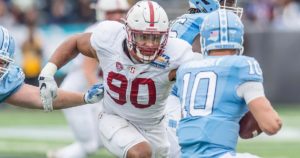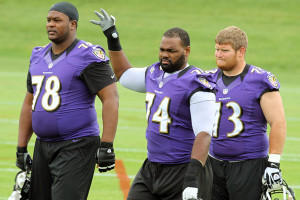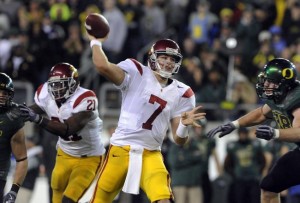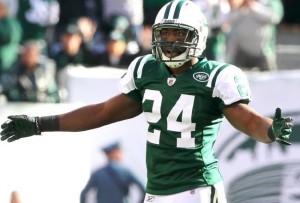The action got started on day two even before the round began. Buffalo, after giving up next year’s first and fourth round picks to move up to acquire Sammy Watkins, responded by trading Steve Johnson to the 49ers on Friday afternoon. Buffalo was able to at least get back a 2015 4th round pick from the 49ers, which could become a 3rd rounder depending on Johnson’s performance this season. This gives Colin Kaepernick another weapon in a contract year, and it provides some short-term insurance (if Father Time outraces Anquan Boldin) and long-term insurance (Michael Crabtree is a free agent after the season) at the position.
The trades in rounds 2 and 3 weren’t very exciting, and they followed a very predictable formula: the team trading down won according to my draft value chart. The fact that my metrics said every team overpaid when trading up does not mean my metrics are wrong; my grades, in addition to being objective, are designed to be aspirational, not predictive. These ratings tell us the actual value provided by players based on historical results. In reality, teams fall in love with a player — and are overconfident in their abilities to scout — and as a result, are willing to lose value when trading up.
My chart recognizes that the right to choose between a mid-2nd and a mid-3rd round pick is not that significant; to a decision maker who believes his scouting skills descended from the heavens, that right to choose is really, really important. Of course, the data suggests otherwise. That said, let’s take a look at what happened on Friday night using my chart and the JJ Trade Value Chart.
1) Washington trades the 34th pick to Dallas for the 47th and 78th picks
According to my chart, this was an amazing trade for Washington, who received 140 cents on the dollar. Even the JJ chart thinks Washington picked up 112.5 cents on the dollar. Picking up an extra 3rd round pick to move down 13 spots was a very nice haul.
The Cowboys traded up for Boise State defensive end Demarcus Lawrence. Dallas was worried the Falcons would take him and apparently viewed him as the clear best RDE available. That’s fine, but the Cowboys gave up two important picks to secure his rights.
2) Seattle trades the 40th and 146th pick to Detroit for the 45th (2nd), 111 (4th), and 227th (7th).
My chart liked the the Seahawks side of the deal, as Seattle picked up a 107.5 cents on the dollar. The JJ chart, on the other hand, thinks Detroit got the slightly better deal , giving up 524 points of value for 533 points.
The Lions traded up for BYU outside linebacker Kyle Van Noy. This is the rare trade up I’ll approve, because well, I watched the 2012 Poinsettia Bowl.
In all, Van Noy made 7.5 disruptive plays in the box score: 3.5 tackles for loss (1.5 sacks), a forced fumble (which he recovered for a touchdown), an interception he returned for a touchdown and a blocked punt.
Van Noy single-handedly scored more points than the BYU offense and accounted for two of BYU’s five takeaways.
Van Noy may not be a great NFL player, but he was an excellent college player and a fun one to watch. Rumor has it the Lions wanted Anthony Barr in the first round, but pairing Eric Ebron with Van Noy might wind up working out even better.
3) The Bills traded the 41st pick to St. Louis for the 44th and 153rd picks
As you might suspect, my chart thought this was a very smooth move for Buffalo, trading 11 points for 13 and receiving 118 cents on the dollar. The JJ chart thought this trade was exactly even, trading 490 points for 490 points.
We know that Jeff Fisher loves his cornerbacks, and the Rams traded up for Florida State’s Lamarcus Joyner. I’m not a slave to my own chart — I recognize that giving up a 5th round pick to ensure that you get your player can be worth it. But my chart recognizes that 5th round picks still have value, and there’s not much difference between the 41st and 44th picks. The Rams probably had a 1st round grade on Joyner and were willing to sacrifice the pick to get him, but the million dollar question is always why didn’t enough other teams have a first round grade on him?
4) Three picks in a row, three trades. Tennessee sent the 42nd pick to Philadelphia for the 54th and 122nd selections.
My chart says the Titans got a nice deal, picking up 122 cents on the dollar. Meanwhile, the JJ chart says the Eagles killed it on this trade, and Tennessee only picked up 85 cents on the dollar. In retrospect, the Seahawks may have won their deal with Detroit, but they almost certainly could have done better than they did in their deal with the Lions. Seattle clearly got the worst deal of the three teams that traded down in the 40 to 42 range.
Philadelphia moved up for Vanderbilt wide receiver Jordan Matthews and paid the price. Matthews may not have made it to 54, so it’s easy to understand why the Eagles made the move. This trade was interesting because of the wildly disparate values on the two charts, but the 122nd pick is not a throwaway. Of course, the Eagles tend to manage the draft very well, so giving up the pick here is not so disheartening: Philadelphia got an extra pick in the Johnny Manziel trade, and didn’t even give up their own pick in the Darren Sproles trade (the Eagles used the pick they got from New England for Isaac Sopoaga).
5) Miami sends the 50th pick to San Diego for the 57th and 125th selections
The Chargers tossed a 4th round pick in to move up 7 spots. That might sound okay, but Miami picked up 132 cents on the dollar in this deal. On the other hand, teams like San Diego are probably using the JJ chart, which says San Diego won this trade (Miami received 94 cents).
San Diego moved up for outside linebacker Jeremiah Attaochu. Presumably the Georgia Tech player was the last pass rusher in the Chargers’ top tier, but a 4th round pick is not pocket change. Like most 3-4 teams, the Chargers really want to add edge rushers. What separates San Diego from the rest is the amount of capital they keep throwing at the position with little results: Jarret Johnson, Dwight Freeney, Larry English, Melvin Ingram are all still on the roster.
6)
7)
The next two trades are best analyzed together. San Francisco owned the 56th pick and sent it to Denver; moments later, the 49ers traded for Miami’s 57th pick.
Combined, San Francisco moved down from 56 to 57 and lost their 242nd pick; in return, the 49ers picked up Denver’s 2015 4th round pick. That’s just beautiful.
This year, Denver picks at 131 in the 4th round. If we say the Broncos will be around there next year, and then apply a 20-spot discount for the time value of draft picks, that would put this at equal to the 151st pick this year. That’s some fuzzy math, of course, but….
If we do that, San Francisco gave up 56 and 242 for 63, 171, and something equivalent to the 151st pick. That means the 49ers robbed the Broncos, getting 143 cents on the dollar. Unfortunately, some of that was then given up when San Francisco sent 63 and 171 for number 57. In that deal, Miami received 113 cents on the dollar according to my chart.
Denver traded up for Indiana wide receiver Cody Latimer; San Francisco traded for Ohio State running back Carlos Hyde. Both players could turn into starts, and in general, I’m less disturbed by a trade up for skill position players. Then again, the Broncos have Demaryius Thomas, Wes Welker, Julius Thomas, and Emmanuel Sanders (not to mention Andre Caldwell and Jordan Norwood), while the 49ers have Frank Gore, Kendall Hunter, Marcus Lattimore. That doesn’t even include LaMichael James, who is probably going to be traded soon.
8) San Francisco gets back into the trading business, sending the 61st pick to Jacksonville for the 70th and 150th selections.
Trading down would seem to make more sense for say, Jacksonville than San Francisco, but what do I know. As you’d expect, the 49ers won the deal, picking up 121 cents on the dollar.
The Jaguars traded up for Penn State wide receiver Allen Robinson. If nothing else, I admire Jacksonville’s dedication to improve the passing game, using the team’s first three picks on Blake Bortles, Marqise Lee, and Robinson. The most important thing, of course, is hitting on the picks, but those players — combined with Cecil Shorts, Ace Sanders, Denard Robinson, and Toby Gerhart — could be part of a fun Jaguars offense in 2015 and 2016. Unfortunately, 2014 probably will look a lot like 2013 still.
9) Oakland sends the 67th pick to Miami for the 81st and 116th picks.
The Dolphins did a nice job adding value with a pair of trade downs earlier, but go the wrong way here. The Raiders pick up 140 cents on the dollar.
The Dolphins traded up for Billy Turner, who is an offensive linemen from North Dakota State. That’s the extent of my scouting report.
If you’re a Miami fan and dismayed that your team traded up (and paid a pretty price to do so) for an FCS offensive linemen, well, over the three trades, I have Miami up 106 cents on the dollar (in total, the Dolphins sent 50/81/116 for 63/67/125/171).
10) Philadelphia trades the 83rd pick to Houston for the 101st and 141st picks
As you’ve come to see, the trading down teams tend to get the (much) better end of the bargain. Here, the Eagles picked up 128 cents on the dollar. On the other hand, the Texans move up for Louis Nix III. This move is okay by me: Nix was a first round pick on some boards, and is a monster nose tackle. Teams can probably neutralize him by double-teaming him, and double-teaming Jadeveon Clowney, and triple-teaming J.J. Watt and yeah I’m okay with what Houston did here.
11) New England trades the 93rd pick to Jacksonville for the 105th and 179th picks
The Patriots receive 116 cents on the dollar here. But again, shouldn’t New England be the team trading up and Jacksonville the one trading down?
12) In what was essentially a mirror of the last deal, San Francisco sent the 94th pick to Cleveland for the 106th and 180th picks. Here, the 49ers received 112 cents on the dollar.
Jacksonville traded up for Miami (FL) guard Brandon Linder. Cleveland traded for Towson running back Terrance West.






